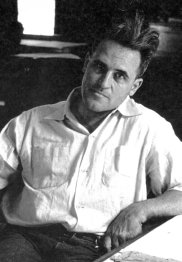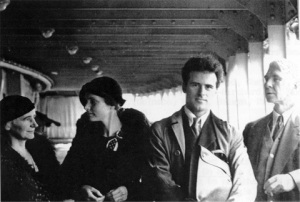 Ernst Bacon (1898-1990) seemed to hold every attribute the modern, archetype artist should have. As friend, author and librettist Paul Horgan remembered, Bacon bristled with, “… energetic views of such various strands of life as the sovereign arts of music, literature, painting and architecture; the morality of education; the splendor of landscape… the leaven of humor; the power of tenderness and the love of women and children and friends; the practice of politics and the need to judge it fiercely; and over all, the abiding radiance of honor.”
Ernst Bacon (1898-1990) seemed to hold every attribute the modern, archetype artist should have. As friend, author and librettist Paul Horgan remembered, Bacon bristled with, “… energetic views of such various strands of life as the sovereign arts of music, literature, painting and architecture; the morality of education; the splendor of landscape… the leaven of humor; the power of tenderness and the love of women and children and friends; the practice of politics and the need to judge it fiercely; and over all, the abiding radiance of honor.”
Truly, Ernst Bacon may be considered a 20th Century Renaissance man: in addition to composing, Bacon concertized as a pianist, conducted, wrote both poetry and prose, and painted. Born and raised in Chicago, Bacon studied mathematics at Northwestern University for three years and then transferred to the University of Chicago; later he received a master’s degree in composition at the University of California at Berkeley. His major teachers were Alexander Raab and Glenn Dillard Gunn for piano, and Karl Weigl and Ernest Bloch for composition.
Though his interests ranged widely, Bacon is primarily known as a composer and specifically acknowledged for his more than 250 songs (especially his settings of Emily Dickinson and Walt Whitman poems). As a composer, Bacon’s considerable output includes works for piano, chamber music, orchestra and the stage. His music, like Aaron Copland’s, identified an American sound that attempted to capture “the poetry, folk songs, jazz rhythms and geography of America” in the first half of the twentieth century (Ernst Bacon Society website).

Despite his significant output, Bacon remains a most remarkably underrated and relatively obscure composer. This is surprising when considering his career: In his lifetime, he held multiple and prominent teaching positions (at Eastman School, San Francisco Conservatory, Syracuse University and other institutions), was repeatedly recognized for his excellence (he received a Pulitzer Scholarship in Music, three Guggenheim Fellowships, and grants from the National Institute of Arts and Letters, the American Society of Authors, Composers, and Publishers, and The National Endowment for the Arts) and was closely associated with some of the leading artistic figures of the day including Copland, Virgil Thompson, Carl Sandburg and Ansel Adams.
Learn more about Ernst Bacon’s REPERTOIRE and THE ERNST BACON PROJECT